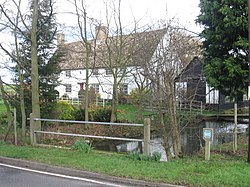Whaddon, Cambridgeshire: Difference between revisions
Created page with '{{Infobox town |name=Whaddon |county=Cambridgeshire |picture=Attractive cottage beside stream in Whaddon - geograph.org.uk - 344172.jpg |picture caption= |os grid ref=TL3546 |la…' |
|||
| (One intermediate revision by the same user not shown) | |||
| Line 14: | Line 14: | ||
|LG district=South Cambridgeshire | |LG district=South Cambridgeshire | ||
}} | }} | ||
'''Whaddon''' is a village in [[Cambridgeshire]], | '''Whaddon''' is a village in [[Cambridgeshire]], four miles north of [[Royston, Hertfordshire|Royston]]. | ||
==History== | ==History== | ||
The western boundary of the parish follows the Roman [[Ermine Street]] (now the A1198), separating it from [[Bassingbourn]] and [[Wendy]], and its northern border follows the [[River Rhee|River Cam (or Rhee)]], dividing it from [[Wimpole]] and [[Orwell, Cambridgeshire|Orwell]]. A stream separates it from [[Kneesworth]] to the south, and field boundaries from [[Melbourn]] to the east.<ref name=victoria>{{cite book|title=A History of the County of Cambridge and the Isle of Ely|volume=8|year=1982|pages=142–151|url=http://www.british-history.ac.uk/report.aspx?compid=66750}}</ref> | The western boundary of the parish follows the Roman [[Ermine Street]] (now the A1198), separating it from [[Bassingbourn]] and [[Wendy]], and its northern border follows the [[River Rhee|River Cam (or Rhee)]], dividing it from [[Wimpole]] and [[Orwell, Cambridgeshire|Orwell]]. A stream separates it from [[Kneesworth]] to the south, and field boundaries from [[Melbourn]] to the east.<ref name=victoria>{{cite book|title=A History of the County of Cambridge and the Isle of Ely|volume=8|year=1982|pages=142–151|url=http://www.british-history.ac.uk/report.aspx?compid=66750}}</ref> | ||
Much of Whaddon was formerly part of the estate of [[Wimpole Hall]], and the hall's South Avenue, originally two double rows of elms planted in 1720 (now oak and lime), stretches | Much of Whaddon was formerly part of the estate of [[Wimpole Hall]], and the hall's South Avenue, originally two double rows of elms planted in 1720 (now oak and lime), stretches a mile across the parish to Ermine Street. The Basin, an octagonal pool of around 150 metres in diameter, was added in 1721 just south of the river but was cleared a few decades later and filled with soil in 1968.<ref name=victoria/> | ||
In 1812, an Act authorised the creation of a canal running from Whaddon to [[Sawston]] as part of the Stort Navigation, but the canal was never dug.<ref name=victoria/> | In 1812, an Act authorised the creation of a canal running from Whaddon to [[Sawston]] as part of the Stort Navigation, but the canal was never dug.<ref name=victoria/> | ||
Latest revision as of 08:51, 6 March 2015
| Whaddon | |
| Cambridgeshire | |
|---|---|

| |
| Location | |
| Grid reference: | TL3546 |
| Location: | 52°5’59"N, 0°1’23"W |
| Data | |
| Population: | 481 (2001) |
| Post town: | Royston |
| Postcode: | SG8 |
| Dialling code: | 01223 |
| Local Government | |
| Council: | South Cambridgeshire |
Whaddon is a village in Cambridgeshire, four miles north of Royston.
History
The western boundary of the parish follows the Roman Ermine Street (now the A1198), separating it from Bassingbourn and Wendy, and its northern border follows the River Cam (or Rhee), dividing it from Wimpole and Orwell. A stream separates it from Kneesworth to the south, and field boundaries from Melbourn to the east.[1]
Much of Whaddon was formerly part of the estate of Wimpole Hall, and the hall's South Avenue, originally two double rows of elms planted in 1720 (now oak and lime), stretches a mile across the parish to Ermine Street. The Basin, an octagonal pool of around 150 metres in diameter, was added in 1721 just south of the river but was cleared a few decades later and filled with soil in 1968.[1]
In 1812, an Act authorised the creation of a canal running from Whaddon to Sawston as part of the Stort Navigation, but the canal was never dug.[1]
Church

The parish church of St Mary consists of a chancel, five-bay aisled and clerestoried nave, south porch, and west tower. The chancel is the oldest part of the present building, dating from the end of the 13th century. The nave and tower were added in the late 14th century.[1]
Village life
In 1875 the Earl of Hardwicke built a school in the village. Numbers fell until in 1924 secondary pupils were sent to Meldreth and Bassingbourn. Finally in 1962 primary pupils were transferred to Orwell Petersfield school and the Whaddon school was closed. The building now serves as the village hall.[1]
There are no longer any pubs in Whaddon. Between 1841 and around 1900 The Pickering Arms was open in the village, becoming a farmhouse after it closed and burning down in around 1970. The Home served coprolite workers at Whaddon Green for several decades in the late 19th century. Though originally part of Melbourn, The Queen Adelaide opened south of Whaddon Green in around 1900, closing in 1956.[2]
A travellers' site is located on the western side of the village; the local council recently announced that the site is to be expanded and improved in a £1.4 million development project.[3]
Outside links
| ("Wikimedia Commons" has material about Whaddon, Cambridgeshire) |
References
- ↑ 1.0 1.1 1.2 1.3 1.4 A History of the County of Cambridge and the Isle of Ely. 8. 1982. pp. 142–151. http://www.british-history.ac.uk/report.aspx?compid=66750.
- ↑ "Village history". Whaddon Village website. http://www.whaddon.org/history_whaddon.html.
- ↑ Cambridge Evening News: £14M Plan for Travellers Site
